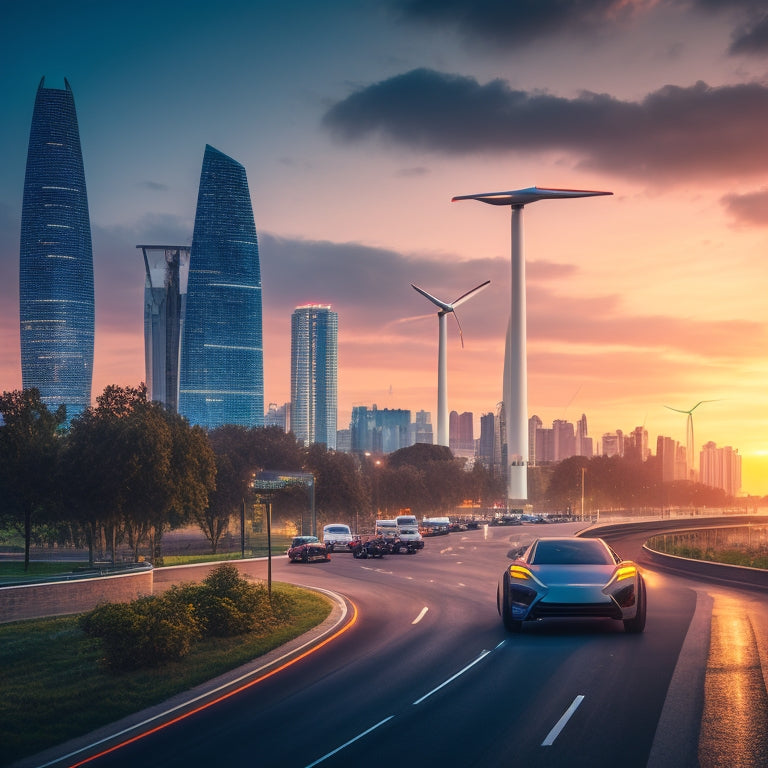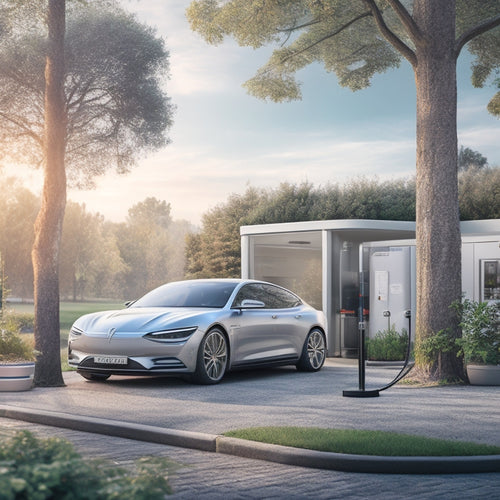
Green City Mobility: 3 EV Solutions for Urban Futures
Share
To create a green city mobility hub, you'll need to focus on three key areas. First, establish a robust electric vehicle infrastructure, prioritizing fast-charging points to combat range anxiety. Next, integrate shared mobility systems that optimize EV usage, reducing privately owned vehicles and promoting a sustainable transportation network. Finally, adopt a holistic approach to city-wide EV adoption, addressing infrastructure, policy, and public education to accelerate uptake. By exploring these solutions, you'll uncover the strategies and innovations that can propel your city towards a sustainable, electric-powered future.
Key Takeaways
• Cities need a strong network of charging stations, with at least 20% being fast-charging to combat range anxiety and support increased demand.
• Integrating shared mobility systems with electric vehicles optimizes usage, reduces privately owned vehicles, and promotes a sustainable transportation network.
• Prioritizing public charging stations in rural areas enhances convenience for electric vehicle owners and increases accessibility.
• Holistic strategies addressing infrastructure, policy, and public education can accelerate electric vehicle adoption in cities.
• Governments can offer incentives like tax breaks to encourage private investment in electric vehicle infrastructure, driving city-wide adoption.
Electric Vehicle Infrastructure
As cities shift to electric vehicles, you'll need a strong network of charging stations, with at least 20% of them being fast-charging points, to support the increased demand for EV infrastructure. This is vital for widespread adoption, as range anxiety remains a significant barrier to EV ownership.
Public charging infrastructure is an essential component, providing drivers with convenient and reliable access to charging points. However, rural areas often lack adequate public charging infrastructure, hindering rural accessibility. To address this, cities can prioritize the installation of public charging stations in rural areas, ensuring that EV owners can charge their vehicles conveniently, regardless of location.
Incorporating fast-charging points into the network will greatly reduce charging times, making long-distance travel more practical. Additionally, strategically placing charging stations near high-traffic areas, such as shopping centers and rest stops, can increase visibility and utilization.
Shared Mobility Systems
By integrating shared mobility systems, you can optimize the use of electric vehicles, reducing the number of privately owned vehicles on the road and promoting a more efficient, sustainable transportation network. This approach allows you to rethink traditional transportation models, focusing on shared mobility solutions that reduce congestion, pollution, and urban sprawl.
Micro transit optimization plays an essential role in this scenario, as it enables you to dynamically adjust transportation services according to real-time demand. By leveraging data analytics and machine learning algorithms, you can identify areas of high demand and allocate EVs accordingly, ensuring that citizens have access to reliable, efficient transportation.
Subscription models are another key component of shared mobility systems, allowing citizens to access a range of transportation options – from electric buses to EV car-sharing services – for a flat monthly fee. This approach not only reduces the financial burden of transportation but also encourages the use of sustainable, eco-friendly transportation methods.
City-Wide EV Adoption
You can accelerate city-wide EV adoption by implementing a holistic strategy that addresses infrastructure, policy, and public education. This multi-faceted approach will help create an ecosystem that supports widespread EV integration.
Infrastructure development is essential, involving the installation of EV charging stations and upgrading the electrical grid to meet increased demand. Governments can offer incentives, such as tax breaks or subsidies, to encourage private investment in EV infrastructure.
Effective policy changes can also drive adoption. Governments can introduce low-emission zones, exempt EVs from traffic restrictions, or offer preferential parking. Additionally, governments can provide education and training programs for mechanics and first responders to make sure they're equipped to handle EVs.
Public education is important in promoting EV adoption. Governments can launch public awareness campaigns highlighting the environmental benefits, cost savings, and performance advantages of EVs. By educating the public, you can increase demand, creating a snowball effect that drives further adoption.
Government incentives, such as rebates or tax credits, can also encourage individuals and businesses to switch to EVs.
Frequently Asked Questions
Can EV Batteries Be Recycled at the End of Their Life Cycle?
You'll be relieved to know that, yes, EV batteries can be recycled at the end of their life cycle, with closed-loop systems enabling battery reuse and minimizing waste, ensuring a sustainable future.
How Will EVS Affect Urban Air Quality in the Long Term?
As you drive through city streets, you'll notice a stark contrast: while EVs won't emit pollutants, they'll still stir up particulate matter, but air pollution mitigation strategies and clean energy corridors will help minimize their long-term impact on urban air quality.
Will EVS Lead to Increased Electricity Demand on the Grid?
As you charge your EV, you'll contribute to increased electricity demand, especially during peak hours, which may strain grid resilience; however, smart grid management and time-of-use pricing can mitigate this impact.
Can EVS Be Used as Energy Storage for the Grid?
You can leverage your EV as energy storage for the grid through smart charging and Vehicle-to-Home (V2H) technology, allowing you to feed excess energy back into the grid when needed, stabilizing the network.
Will EV Adoption Lead to Job Losses in Traditional Industries?
As you navigate the EV adoption landscape, you'll see a workforce shift, disrupting traditional industries, impacting auto workers; however, with job retraining and supply chain adaptations, you can mitigate the economic impact of this industry disruption.
Related Posts
-

3 Ways to Increase Motorcycle Horsepower
You're about to unleash your motorcycle's hidden power by exploiting three key areas. First, upgrade your electric mo...
-

7 Best Home Electric Vehicle Charging Station Setups
When selecting a home electric vehicle charging station setup, consider a Level 2 charging station with a dedicated 4...
-

Why Go Solo in Urban Transportation?
You're taking control of your daily commute by ditching the crowds and going solo, and that's a smart move. By choosi...


